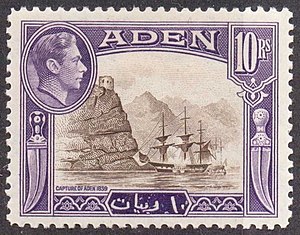HMS Volage (1825)

HMS Volage depicted on a stamp commemorating the Aden Expedition
|
|
| History | |
|---|---|
|
|
|
| Name: | HMS Volage |
| Builder: | Portsmouth Dockyard |
| Launched: | 19 February 1825 |
| In service: | 1825-1864 |
| Refit: | 1847 |
| Struck: | 1864 |
| Honours and awards: |
Aden 1839, Baltic 1855 |
| Fate: | Broken up 12 December 1864 |
| Status: | Scrapped |
| General characteristics | |
| Tons burthen: | 516 (bm) |
| Length: | 111ft |
| Decks: | Two |
| Armament: | 50 cannon |
HMS Volage was a Sixth-rate Sailing frigate launched in 1825 for the British Royal Navy.
Volage served as the lead ship in the Aden Expedition due to her being the largest and best armed of the ships assembled.
In 1831, Volage was docked in Rio de Janeiro (at the time capital of the Empire of Brazil) alongside HMS Warspite. Volage was the vessel that took Dom Pedro I, who had just abdicated the Brazilian throne, to Portugal, in order to face his brother Dom Miguel in the context of the ongoing Portuguese Civil War of 1828-1834.
Volage fought in the Battle of Chuenpi during the First Opium War under the command of Captain Henry Smith. In 1847 she was converted into a survey ship. Volage was deployed to the Baltic during the Crimean War. At one point geologist Thomas Abel Brimage Spratt served aboard her.
The Navy scrapped Volage in 1864.
...
Wikipedia
